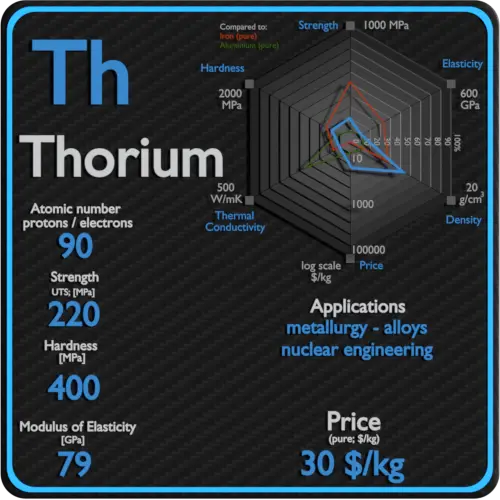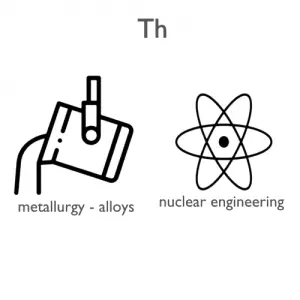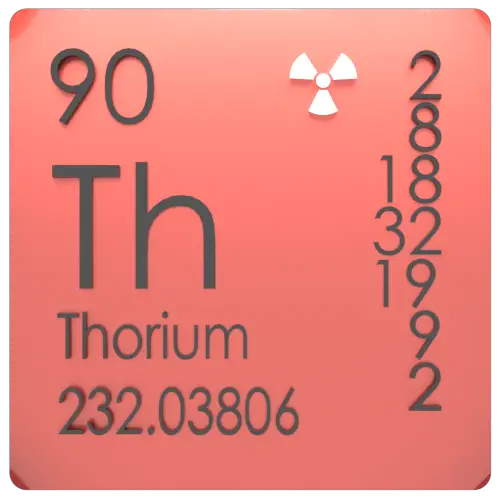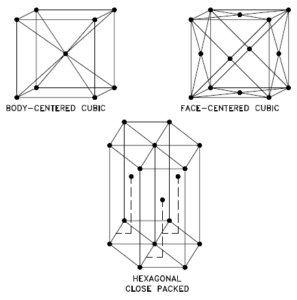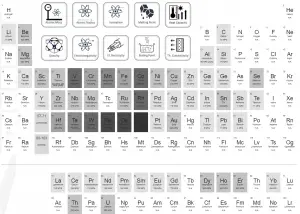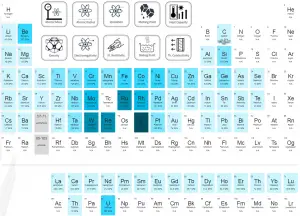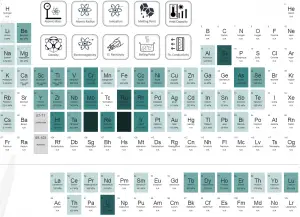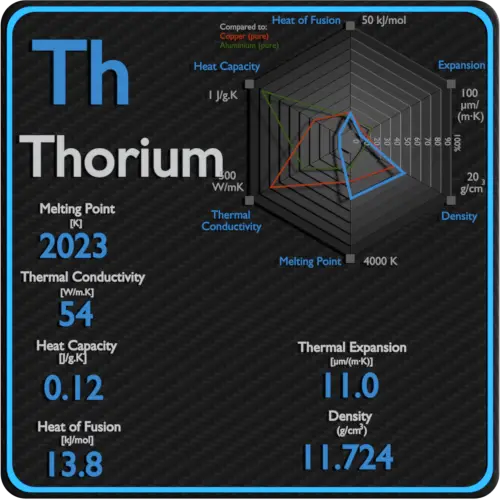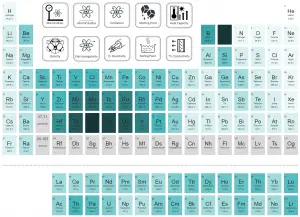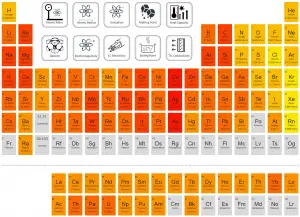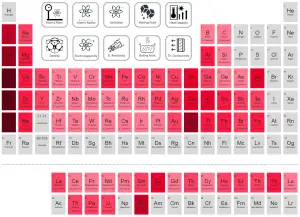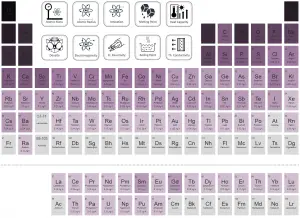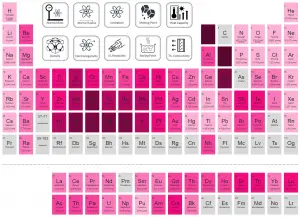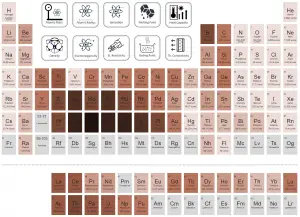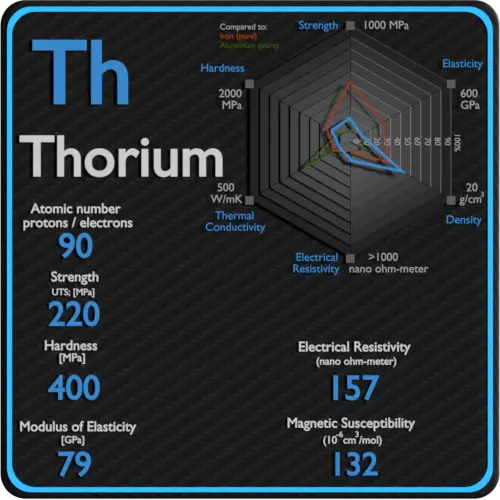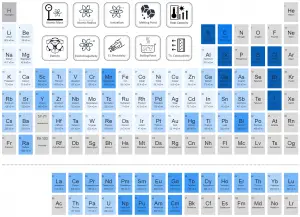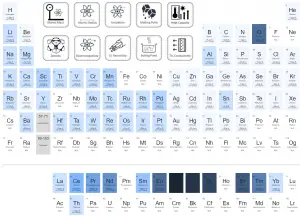About Thorium
Thorium metal is silvery and tarnishes black when exposed to air, forming the dioxide. Thorium is moderately hard, malleable, and has a high melting point. Thorium is a naturally-occurring element and it is estimated to be about three times more abundant than uranium. Thorium is commonly found in monazite sands (rare earth metals containing phosphate mineral).
Summary
| Element | Thorium |
| Atomic number | 90 |
| Element category | Rare Earth Metal |
| Phase at STP | Solid |
| Density | 11.724 g/cm3 |
| Ultimate Tensile Strength | 220 MPa |
| Yield Strength | 144 MPa |
| Young’s Modulus of Elasticity | 79 GPa |
| Mohs Scale | 3 |
| Brinell Hardness | 400 MPa |
| Vickers Hardness | 350 MPa |
| Melting Point | 1750 °C |
| Boiling Point | 4790 °C |
| Thermal Conductivity | 54 W/mK |
| Thermal Expansion Coefficient | 11 µm/mK |
| Specific Heat | 0.12 J/g K |
| Heat of Fusion | 13.8 kJ/mol |
| Heat of Vaporization | 514.4 kJ/mol |
| Electrical resistivity [nanoOhm meter] | 157 |
| Magnetic Susceptibility | +132e-6 cm^3/mol |
Applications of Thorium
Most thorium applications use its dioxide (sometimes called “thoria” in the industry), rather than the metal. This compound has a melting point of 3300 °C (6000 °F), the highest of all known oxides; only a few substances have higher melting points.[46] This helps the compound remain solid in a flame, and it considerably increases the brightness of the flame; this is the main reason thorium is used in gas lamp mantles. All substances emit energy (glow) at high temperatures, but the light emitted by thorium is nearly all in the visible spectrum, hence the brightness of thorium mantles. Thorium is an important alloying agent in magnesium, as it imparts greater strength and creep resistance at high temperatures. Thorium oxide is used as an industrial catalyst. Other uses for thorium include heat-resistant ceramics, aircraft engines, and in light bulbs. Thorium can be used as a source of nuclear power. It is about three times as abundant as uranium and about as abundant as lead, and there is probably more energy available from thorium than from both uranium and fossil fuels. 232Th is a fertile isotope. 232Th is not capable of undergoing fission reaction after absorbing thermal neutron, on the other hand 232Th can be fissioned by fast neutron with energy higher than >1MeV. India and China are in the process of developing nuclear power plants with thorium reactors, but this is still a very new technology. Thorium dioxide was formerly added to glass during manufacture to increase the refractive index, producing thoriated glass for use in high-quality camera lenses.
Production and Price of Thorium
Raw materials prices change daily. They are primarily driven by supply, demand and energy prices. In 2019, prices of pure Thorium were at around 30 $/kg.
Thorium is a naturally-occurring element and it is estimated to be about three times more abundant than uranium. Thorium is commonly found in monazite sands (rare earth metals containing phosphate mineral). The current reliance on monazite for production is due to thorium being largely produced as a by-product; other sources such as thorite contain more thorium and could easily be used for production if demand rose.
Source: www.luciteria.com
Mechanical Properties of Thorium
Strength of Thorium
In mechanics of materials, the strength of a material is its ability to withstand an applied load without failure or plastic deformation. Strength of materials basically considers the relationship between the external loads applied to a material and the resulting deformation or change in material dimensions. In designing structures and machines, it is important to consider these factors, in order that the material selected will have adequate strength to resist applied loads or forces and retain its original shape. Strength of a material is its ability to withstand this applied load without failure or plastic deformation.
For tensile stress, the capacity of a material or structure to withstand loads tending to elongate is known as ultimate tensile strength (UTS). Yield strength or yield stress is the material property defined as the stress at which a material begins to deform plastically whereas yield point is the point where nonlinear (elastic + plastic) deformation begins.
See also: Strength of Materials
Ultimate Tensile Strength of Thorium
Ultimate tensile strength of Thorium is 220 MPa.
Yield Strength of Thorium
Yield strength of Thorium is 144 MPa.
Modulus of Elasticity of Thorium
The Young’s modulus of elasticity of Thorium is 144 MPa.
Hardness of Thorium
In materials science, hardness is the ability to withstand surface indentation (localized plastic deformation) and scratching. Brinell hardness test is one of indentation hardness tests, that has been developed for hardness testing. In Brinell tests, a hard, spherical indenter is forced under a specific load into the surface of the metal to be tested.
Brinell hardness of Thorium is approximately 400 MPa.
The Vickers hardness test method was developed by Robert L. Smith and George E. Sandland at Vickers Ltd as an alternative to the Brinell method to measure the hardness of materials. The Vickers hardness test method can be also used as a microhardness test method, which is mostly used for small parts, thin sections, or case depth work.
Vickers hardness of Thorium is approximately 350 MPa.
Scratch hardness is the measure of how resistant a sample is to permanent plastic deformation due to friction from a sharp object. The most common scale for this qualitative test is Mohs scale, which is used in mineralogy. The Mohs scale of mineral hardness is based on the ability of one natural sample of mineral to scratch another mineral visibly.
Thorium is has a hardness of approximately 3.
See also: Hardness of Materials
Thorium – Crystal Structure
A possible crystal structure of Thorium is face-centered cubic structure.
In metals, and in many other solids, the atoms are arranged in regular arrays called crystals. A crystal lattice is a repeating pattern of mathematical points that extends throughout space. The forces of chemical bonding causes this repetition. It is this repeated pattern which control properties like strength, ductility, density, conductivity (property of conducting or transmitting heat, electricity, etc.), and shape. There are 14 general types of such patterns known as Bravais lattices.
See also: Crystal Structure of Materials
Crystal Structure of Thorium

Thermal Properties of Thorium
Thorium – Melting Point and Boiling Point
Melting point of Thorium is 1750°C.
Boiling point of Thorium is 4790°C.
Note that, these points are associated with the standard atmospheric pressure.
Thorium – Thermal Conductivity
Thermal conductivity of Thorium is 54 W/(m·K).
The heat transfer characteristics of a solid material are measured by a property called the thermal conductivity, k (or λ), measured in W/m.K. It is a measure of a substance’s ability to transfer heat through a material by conduction. Note that Fourier’s law applies for all matter, regardless of its state (solid, liquid, or gas), therefore, it is also defined for liquids and gases.
Coefficient of Thermal Expansion of Thorium
Linear thermal expansion coefficient of Thorium is 11 µm/(m·K)
Thermal expansion is generally the tendency of matter to change its dimensions in response to a change in temperature. It is usually expressed as a fractional change in length or volume per unit temperature change.
Thorium – Specific Heat, Latent Heat of Fusion, Latent Heat of Vaporization
Specific heat of Thorium is 0.12 J/g K.
Heat capacity is an extensive property of matter, meaning it is proportional to the size of the system. Heat capacity C has the unit of energy per degree or energy per kelvin. When expressing the same phenomenon as an intensive property, the heat capacity is divided by the amount of substance, mass, or volume, thus the quantity is independent of the size or extent of the sample.
Latent Heat of Fusion of Thorium is 13.8 kJ/mol.
Latent Heat of Vaporization of Thorium is 514.4 kJ/mol.
Latent heat is the amount of heat added to or removed from a substance to produce a change in phase. This energy breaks down the intermolecular attractive forces, and also must provide the energy necessary to expand the gas (the pΔV work). When latent heat is added, no temperature change occurs. The enthalpy of vaporization is a function of the pressure at which that transformation takes place.
Thorium – Electrical Resistivity – Magnetic Susceptibility
Electrical property refers to the response of a material to an applied electric field. One of the principal characteristics of materials is their ability (or lack of ability) to conduct electrical current. Indeed, materials are classified by this property, that is, they are divided into conductors, semiconductors, and nonconductors.
See also: Electrical Properties
Magnetic property refers to the response of a material to an applied magnetic field. The macroscopic magnetic properties of a material are a consequence of interactions between an external magnetic field and the magnetic dipole moments of the constituent atoms. Different materials react to the application of magnetic field differently.
See also: Magnetic Properties
Electrical Resistivity of Thorium
Electrical resistivity of Thorium is 157 nΩ⋅m.
Electrical conductivity and its converse, electrical resistivity, is a fundamental property of a material that quantifies how Thorium conducts the flow of electric current. Electrical conductivity or specific conductance is the reciprocal of electrical resistivity.
Magnetic Susceptibility of Thorium
Magnetic susceptibility of Thorium is +132e-6 cm^3/mol.
In electromagnetism, magnetic susceptibility is the measure of the magnetization of a substance. Magnetic susceptibility is a dimensionless proportionality factor that indicates the degree of magnetization of Thorium in response to an applied magnetic field.
